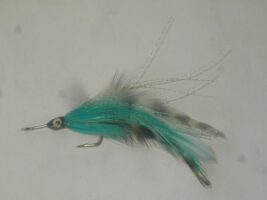Your cart is currently empty!
Tarpon blue grizzly fly
Tarpon Blue Grizzly Fly ? classic fly pattern featuring blue and grizzly materials, proven effective for challenging tarpon fishing conditions.
Description
Product Overview and Heritage?The Tarpon Blue Grizzly represents a classic evolution in tarpon fly design, featuring a unique combination of blue and grizzly materials that create a highly effective baitfish imitation. This specialized pattern incorporates traditional materials with precise tying methods, making it particularly effective for imitating small baitfish while providing both realistic appearance and exceptional durability. Originally developed for the demanding conditions of Keys tarpon fishing, this pattern has become a reliable choice for serious anglers targeting large tarpon, consistently producing results in challenging situations.
Design Features and Materials?Hook Characteristics:
- Premium saltwater hook
- Available sizes: 2/0-4/0
- Heavy wire construction
- Wide gap design
- Chemically sharpened point
- Stainless steel finish
- Optimal hook strength
- Enhanced penetration design
- Perfect size-to-weight ratio
- Corrosion resistance
Material Components:
- Grizzly hackle
- Blue hackle
- Flash materials
- Enhanced durability
- Marine-grade materials
- Color-fast characteristics
- Movement enhancement
- Natural appearance
- Balanced design
- Realistic profile
Construction and Tying Process?The pattern’s success relies on precise construction methods:
- Balanced proportions
- Strategic hackle placement
- Proper material layering
- Reinforced connections
- Material integration
- Enhanced durability features
- Wing shaping
- Profile consistency
- Movement optimization
- Flash placement
Fishing Applications and Techniques?Presentation Methods:
- Strip retrieve
- Figure-eight retrieve
- Multiple angles
- Depth control
- Pattern placement
- Current fishing
- Structure targeting
- Cross-current strips
- Action variation
- Traditional methods
Specialized Applications:
- Rolling tarpon
- Laid-up fish
- Structure fishing
- Clear conditions
- Low light periods
- Dawn/dusk periods
- Search pattern
- Active fish
- High-pressure situations
- Technical water
Seasonal Effectiveness?Spring Performance:
- Early season success
- Mixed techniques
- Weather changes
- Pattern selection
- Temperature increases
- Fish movement
- Feeding windows
- Natural cycles
- Light conditions
- Migration patterns
Summer Strategy:
- Peak tarpon season
- Morning/evening peaks
- Temperature adaptation
- Feeding patterns
- Oxygen levels
- Light penetration
- Fish behavior
- Water conditions
- Current seams
- Structure targeting
Fall Applications:
- Late season opportunities
- Cooling waters
- Changed light conditions
- Transitional periods
- Selective takes
- Pattern visibility
- Fish location
- Temperature drops
- Migration patterns
- Feeding windows
Habitat and Water Types?Water Applications:
- Saltwater flats
- Channel edges
- Ocean side
- Clear water
- Turbid conditions
- Structure areas
- Current seams
- Drop-offs
- Holding water
- Coastal waters
Specialized Environments:
- Various waters
- Technical flats
- High current areas
- Complex structures
- Bank edges
- Deep channels
- Different depths
- Inlet mouths
- Current breaks
- Bridge channels
Target Species and Behavior?Primary Species:
- Tarpon
- Jack Crevalle
- Snook
- Multiple Species
- Aggressive Feeders
- Surface Feeders
- Migratory Fish
- Technical Fish
Behavioral Patterns:
- Rolling activity
- Aggressive takes
- Pattern recognition
- Natural behavior
- Opportunistic strikes
- Selective periods
- Strike triggers
- Visual stimulation
- Lateral line response
- Competitive behavior
Rigging Recommendations?Leader Setup:
- 12-14 foot leaders
- 60-80lb shock tippet
- Tapered leaders
- Fluorocarbon options
- Loop-to-loop connections
- Proper presentation
- Adequate stiffness
- Knot strength
- Breaking strain
- Abrasion resistance
Presentation Options:
- Single fly
- Multiple retrieves
- Traditional methods
- Modern techniques
- Line matching
- Leader design
- Tippet selection
- Depth control
- Strip adjustment
- Action variation
Professional Applications?Guide Usage:
- Client-friendly pattern
- Proven success rates
- Consistent performance
- Easy presentation
- Multiple techniques
- Teaching tool
- Confidence pattern
- Versatile applications
- Durability
- Hook-up ratio
Tournament Usage:
- Competition proven
- Technical water success
- Pressure adaptation
- Quick-change capability
- Consistent performance
- Pattern rotation
- Size variation
- Color selection
- Presentation options
- Result tracking
Advanced Technical Applications?The Tarpon Blue Grizzly excels in specific technical situations that require precise presentation and movement control. When fishing tarpon environments, the pattern performs exceptionally well in the following scenarios:
- Channel edges with depths of 4-20 feet
- Rolling fish in clear water
- Areas with active bait schools
- Current edges during active feeding periods
- Bridge channels and structure
The pattern’s effectiveness can be enhanced through specialized presentation techniques:
- Variable strip retrieves
- Quick, aggressive strips
- Micro-adjustments to strip speed
- Strategic pauses during retrieval
- Counter-current presentation in complex flows
Water temperature significantly impacts the pattern’s effectiveness:
- Optimal performance in 75-85?F range
- Increased activity during warming trends
- Enhanced success during stable barometric conditions
- Peak effectiveness during dawn/dusk periods
- Adapted presentation based on metabolic activity
Care and Maintenance?Post-Fishing Care:
- Thorough freshwater rinse
- Material grooming
- Hook inspection
- Hackle maintenance
- Material preservation
- Storage preparation
- Pattern inspection
- Shape verification
- Performance testing
- Movement checking
Storage Requirements:
- Dry environment
- UV protection
- Separate compartments
- Regular inspection
- Moisture prevention
- Temperature control
- Light protection
- Ventilation needs
- Box organization
- Inventory management
Environmental Considerations?Conservation Features:
- Sustainable materials
- Durable construction
- Catch-and-release friendly
- Minimal environmental impact
- Eco-conscious design
- Material selection
- Ethical considerations
- Resource protection
- Species conservation
- Environmental awareness
Material Selection:
- Responsible sourcing
- Quality components
- Mixed elements
- Ethical production
- Sustainable practices
- Environmental impact
- Material longevity
- Waste reduction
- Local materials
- Eco-conscious design
Additional information
| Hook type | Barbed Hooks, Barbless Hooks |
|---|---|
| Hook size | 1/0, 2, 4, 6 |







